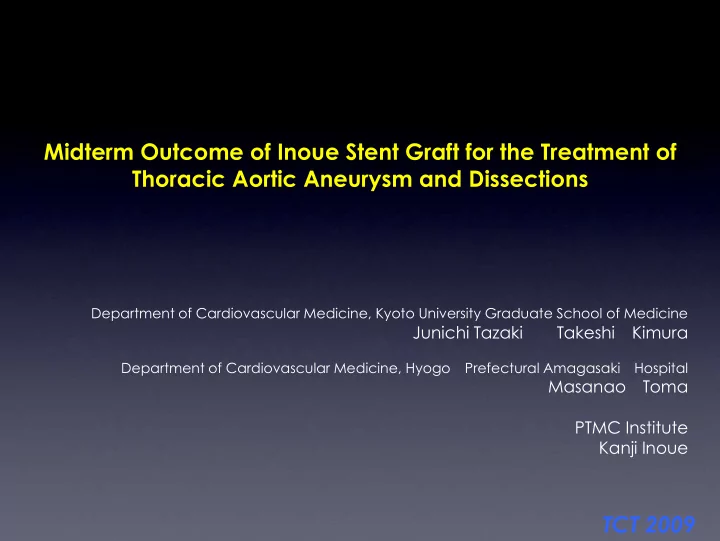

Midterm Outcome of Inoue Stent Graft for the Treatment of Thoracic Aortic Aneurysm and Dissections Department of Cardiovascular Medicine, Kyoto University Graduate School of Medicine Junichi Tazaki Takeshi Kimura Department of Cardiovascular Medicine, Hyogo Prefectural Amagasaki Hospital Masanao Toma PTMC Institute Kanji Inoue TCT 2009
Back ground The efficacy of endovascular stent-graft placement for thoracic aortic aneurysms is established. However, the indication of commercially available stent graft is limited. The Inoue stent-graft has branched design and flexible structure, which is available for various kinds of aneurysms and dissections, including those with left subclavian artery involvement, short neck length(<2cm) or tourtuosity of aorta. TCT 2009
The Inoue endovascular grafting system Stent graft Graft material: woven Dacron polyester fabric cylinder Stent material: extra-flexible nickel titanium wire Sealing ring is covered by small Dacron cuffs Support device detachable carrying wire two detachable traction wires balloon catheter flexible introducer sheath (20Fr to 24Fr) TCT 2009
The procedure of single-branched stent-graft placement. Successful endovascular repair of an aneurysm of the ductus diverticulum with a branched stent graft: case report and review of literature. Saito.N et al J Vasc Surg. 2004 Dec;40(6):1228-33. TCT 2009
Case of aneurysm 67 y.o. male pre post TCT 2009
Case of dissection 65 y.o. male primary entry pre 1Mo 6Mo
Inoue Stent Graft Thoracic Aortic Aneurysm and Dissections Patient characteristics (n=87) Study period: 2003.3 - 2009.07 72 ± 11 y.o. Age >80 y.o. 25 (29%) Male 61 (70%) Co-morbidity Previous cardiothoracic surgery 25 (29%) Ischemic heart disease 30 (35%) Cerebrovascular disease 15 (17%) Pulmonary dysfunction 18 (21%) Chronic kidney disease 27 (31%) Malignancy 14 (16%) Smoker 52 (59%) TCT 2009
Patient characteristics (n=87) 58.4 ± 9.9(mm) Diameter of aneurysm Emergent case 10 (11%) Etiology of aneurysm Atherosclerotic 58 (67%) Dissection 24 (28%) Ductus diverticulum 2 (2%) Inflammation 2 (2%) Anastmotic 1 (1%) TCT 2009
Procedure characteristics (n=87) 22.0 ± 1.7 Sheath size (Fr) Graft type Branched graft 47 (54%) Single branched 42 (48%) Single branched + straight 5 (6%) Straight graft 40 (46%) Straight 33 (38%) Straight + Straight 7 (8%) Anesthesia Focal 21 (24%) Epidural 60 (69%) General 6 (7%) TCT 2009
Procedure characteristics (n=87) Procedure time 231 ± 83 min skin to skin 137 ± 73 min sheath to sheath 272 ± 127ml Contrast medium 30 ± 32 day Hospital stay 8-214, median 19 day TCT 2009
Initial (30-day) result n=87 Deployment success 87 (100%) Peri-operative death 1 (1%) Surgical conversion 1 (1%) Type I /III endoleak 8 (9%) / 0 (0%) Stroke 4 (4.5%) (3 cases in single branched, 1 case in Straight) Paraplegia 3 (3.4%) Aoritc dissection 1 (1.1%) Access artery perforation 3 (3.4%) Cholesterol embolism 3 (3.4%) TCT 2009
Midterm result mean follow up 29 ± 21 month median 24month Total (n=87) Clinical success 78 Aneurysm related death 2 Aneurysm rupture 1 Surgical conversion 2 Persistent Type I/III endoleak 3 / 0 Aneurysm expansion 4 Graft infection 0 Graft thrombosis 0 Re intervention 6 (Success in 5 cases) clinical success (Assisted): Free from type I/III leak, aneurysm related death, aneurysm rupture, surgical conversion graft infection or thrombsis, aneurysm expansion Including cases assisted by re-intervention TCT 2009 Reporting standards for endovascular aortic aneurysm repair JOURNAL OF VASCULAR SURGERY Volume 35, Number 5
Midterm result CT follow mean follow up 24 ± 18 month Change in aneurysm size n=84 Expansion 4 No change 43 Decrease 37 TCT 2009
Survival 1.0 Aneurysm related death 2.3% 0.9 All cause death survival 20% 0.8 0.7 0 1 2 3 year N of Pt at risk 87 69 47 33 TCT 2009
Clinical success 1.0 Aneurysm related death 0.9 87% event free rate 0.8 0.7 0 1 2 3 year N of Pt at risk 87 69 47 33 clinical success (Assisted): Free from type I/III leak, aneurysm related death, aneurysm rupture, surgical conversion graft infection or thrombsis, aneurysm expansion TCT 2009 Including cases assisted by re-intervention
Summary 1. More than half patients need branched graft for left subclavian artery to obtain the proximal landing zone. 2. Deployment of Inoue stent-graft was performed successfully in all cases. 1. The 3-year cumulative aneurysm related and overall mortality was 2.3% ( ≒ 0.8%/year), and 20% ( ≒ 6.8%/year) respectively. 2. The 3-year event free rate was 87% including 5 cases required re- intervention.
Conclusion The acceptable midterm result of Inoue stent graft for thoracic aortic aneurysms and dissections was demonstrated. The Inoue stent graft is able to expand the indication of endovascular repair for thoracic aortic aneurysms and dissections without surgical reconstruction of left subclavian artery. TCT 2009
End
Recommend
More recommend